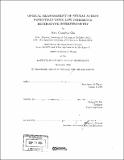| dc.contributor.advisor | Michael S. Feld. | en_US |
| dc.contributor.author | Chu, Mark Changhao, 1978- | en_US |
| dc.contributor.other | Massachusetts Institute of Technology. Dept. of Physics. | en_US |
| dc.date.accessioned | 2005-09-27T17:32:25Z | |
| dc.date.available | 2005-09-27T17:32:25Z | |
| dc.date.copyright | 2004 | en_US |
| dc.date.issued | 2004 | en_US |
| dc.identifier.uri | http://hdl.handle.net/1721.1/28655 | |
| dc.description | Thesis (S.M.)--Massachusetts Institute of Technology, Dept. of Physics, 2004. | en_US |
| dc.description | Includes bibliographical references (p. 91-94). | en_US |
| dc.description.abstract | We present a novel non-invasive optical method for detection of neural action potentials using low coherence interferometry. The dual beam heterodyne interferometer (DBHI) is a modified Michelson with a low coherence source and an optical referencing method capable of detecting sub-nanometer optical path changes. In this interferometer, acousto-optical modulators were used to produce an interfering heterodyne signal between the sample and a nearby surface. To cancel the noise, a differential phase measurement was made between this heterodyne signal and a stable reference heterodyne. DBHI has a stability of 30 picometers over 100ms. We have used this interferometer to measure the expansion of the nerve surface during the action potential. We have measured a displacement of 2-6nm using the nerves from the walking leg of a lobster. A correlation experiment showed that the optical phase signal (the swelling) from the axon during action potential can be identified with the electric signal from the extracellular electrophysiology. A dual-beam probe was designed and built based on this interferometer. The probe is a fiber optic unit with an integrated referencing surface. The probe simplified the data taking process as well as improved the overall S/N ratio by 10 times. The compactness of the probe will allow us to obtain full field phase images with high precision and good maneuvering capability. It will be used in future studies of the action potential. Results from the nerve experiment together with the addition of this probe indicate that DBHI is a promising instrument for studying in-vitro neural activity as well as other biophysical applications, such as the study of cochlear dynamics. | en_US |
| dc.description.statementofresponsibility | by Mark Changhao Chu. | en_US |
| dc.format.extent | 94 p. | en_US |
| dc.format.extent | 3997526 bytes | |
| dc.format.extent | 4008103 bytes | |
| dc.format.mimetype | application/pdf | |
| dc.format.mimetype | application/pdf | |
| dc.language.iso | en_US | |
| dc.publisher | Massachusetts Institute of Technology | en_US |
| dc.rights | M.I.T. theses are protected by copyright. They may be viewed from this source for any purpose, but reproduction or distribution in any format is prohibited without written permission. See provided URL for inquiries about permission. | en_US |
| dc.rights.uri | http://dspace.mit.edu/handle/1721.1/7582 | |
| dc.subject | Physics. | en_US |
| dc.title | Optical measurement of neural action potentials using low coherence heterodyne interferometry | en_US |
| dc.type | Thesis | en_US |
| dc.description.degree | S.M. | en_US |
| dc.contributor.department | Massachusetts Institute of Technology. Department of Physics | |
| dc.identifier.oclc | 58966168 | en_US |
